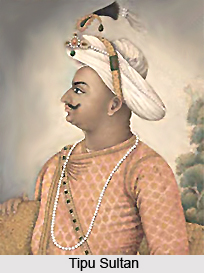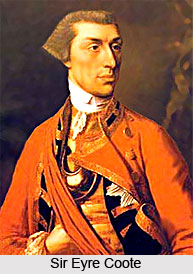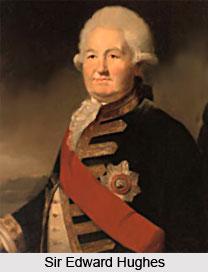 The Second Anglo-Mysore War was a conflict between the British kingdom and the kingdom of Mysore. During that time, Mysore was a key French ally in India. As a result, the Franco-British conflict raging on account of the American Revolutionary aided to spark Anglo-Mysorean antagonisms in India.
The Second Anglo-Mysore War was a conflict between the British kingdom and the kingdom of Mysore. During that time, Mysore was a key French ally in India. As a result, the Franco-British conflict raging on account of the American Revolutionary aided to spark Anglo-Mysorean antagonisms in India.
During July 1780, following the failure of negotiations regarding his grievances with the British, Hyder Ali of Mysore (c.1722-1782) vigorously prosecuted war against Madras. With an army of 80,000 to 90,000 men, Hyder Ali burned and destroyed much of the countryside around Vellore and Madras.
On 10th September, Mysore forces led by Tipu Sultan, the eldest son of Hyder Ali, annihilated a British force of approximately 3800, led by Colonel William Bailie (d. 1782) at Polilur. On 3rd November, Hyder Ali captured the fort at Arcot. In subsequent engagements, the British fell back on Madras.
In November 1780, Warren Hastings, the then Governor-General of India, took several measures to protect Madras. He forwarded Sir Eyre Coote (1726-1783) as the new commander. Hastings also sent 550 European troops, with an emphasis of the artillery and five battalions of Bengal Native Infantry. In January 1781, Coote marched towards Wandiwash. This proved sufficiently threatening to force Hyder Ali to abandon his siege of the locale.
 In January 1781, a French fleet of eleven ships, which had a previous encounter with the British, arrived at Pondicherry. With little water and fearing the arrival of a British fleet, it departed on February 15 for the Isle de France. On 18th June, Coote was held back in his assault on the fortified Pagoda of Chillambram. On 22nd June, Lord Macartney (1737-1806) arrived in Madras and assumed the governorship of the place.
In January 1781, a French fleet of eleven ships, which had a previous encounter with the British, arrived at Pondicherry. With little water and fearing the arrival of a British fleet, it departed on February 15 for the Isle de France. On 18th June, Coote was held back in his assault on the fortified Pagoda of Chillambram. On 22nd June, Lord Macartney (1737-1806) arrived in Madras and assumed the governorship of the place.
Between the months of July-September, Coote won a series of victories at Porto Novo (July 1), Polilur (Aug. 2) and Sholinghur (Sept. 27) over the forces of Mysore. However, on 1st July, near Porto Novo, General Sir Hector Munro (1726-1805) wholly crushed the army of Hyder Ali. This secured for the British the strategic control of the southern provinces of Madras as Tipu Sultan also raised his siege of Wandiwash.
On 27th August, in the region of Tripassore, the British fought a bloody battle to gain victory over Hyder Ali. But, in the process, they lost more than 600 men. On 12th November, Munro captured the Dutch port of Nagapattinam and then won subsequent victories in Ceylon (Sri Lanka) over the Dutch in January 1782.
Later, the French naval forces of Admiral Suffren (1726-1788) and British Navy led by Vice-Admiral Sir Edward Hughes fought a series of five naval engagements off the coasts of Coromandel and Ceylon. Neither navy was however able to gain a level of dominance.
Between 16th to 18 February 1782, Tipu Sultan surprised and captured Colonel John Braithwaite and a body of 1700 troops at Tanjore.
 The Second Mysore War went through further developments in 1783. Brigadier-General Richard Mathews invaded Mysore in that year and captured Mangalore. Tipu Sultan by that time had taken command of the Mysore Army on the death of his father Hyder Ali. In turn, Tipu Sultan quickly captured Mathews and the British force.
The Second Mysore War went through further developments in 1783. Brigadier-General Richard Mathews invaded Mysore in that year and captured Mangalore. Tipu Sultan by that time had taken command of the Mysore Army on the death of his father Hyder Ali. In turn, Tipu Sultan quickly captured Mathews and the British force.
As a consequence, on 11th March 1784, Lord Macartney negotiated the Treaty of Mangalore which brought an end to the Second Mysore War. The terms included the mutual restitution of prisoners and conquests; Hastings rejected the agreement as Mysore failed to keep its terms. The treaty is an important document in the history of India. It was the last instance when an Indian power dictated terms to the British, who were made to play the role of humble petitioners for peace.
On 17th August 1780, Warren Hastings, as Governor-General of India and Philip Francis, as Member of Council, fought a duel with pistols at a distance of fourteen paces. Francis was seriously wounded in the exchange of fire.
On 15th January 1781, Lord North established two Parliamentary committees. The first, a Select Committee, sought to make a public investigation of the supposed misconduct of the East India Company in India. The second, a Secret Committee, focused on the East India Company`s financial affairs. In a report of April 30 the Select Committee, led by Henry Dundas (1742-1811), charged Hastings with starting the war in the Carnatic with Hyder Ali. Sir Thomas Rumbold (1736-1791), Governor of Madras, was also singled out for criticism. In consequence, Dundas forced through the Parliament a resolution seeking Hastings` resignation as Governor-General of India. The Company simply ignored the demand.



















